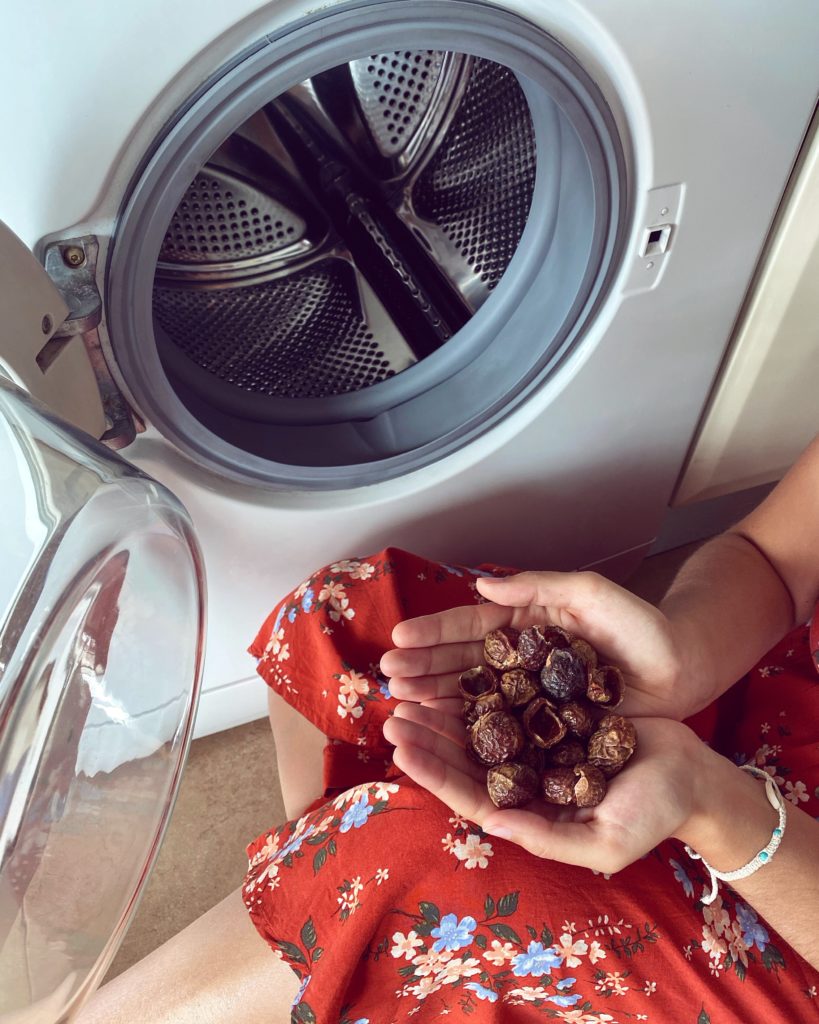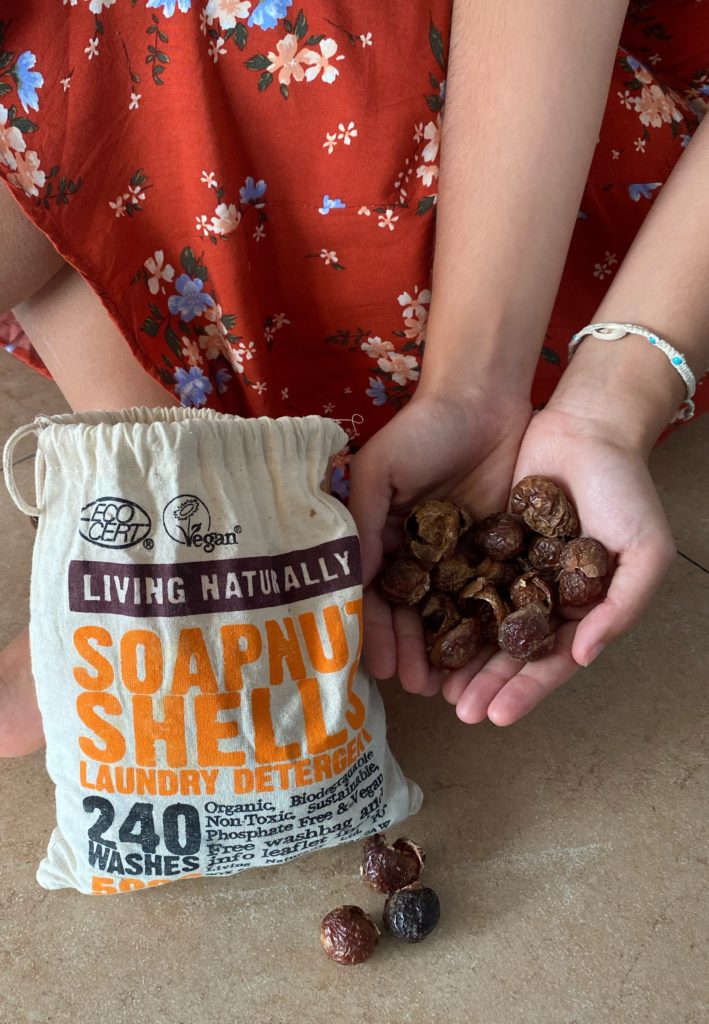
A sustainable alternative to detergents
The soap nuts are getting more known lately as an alternative to the common detergents that we normally use for our clothes and they are a great option to have at home! But after all, what are they? These nuts are fruits from a tree that has its origins in India and Nepal and they are known as soap nuts due to its main component: the saponin. This component, when in contact with water, creates foam, transforming it into a natural soap.
But why should we use these nuts and not the regular detergents from the supermarket? And what are the real environmental impacts that those detergents can have?
This is a subject that is not much spoken when people mention a more sustainable lifestyle since we have been using detergents all our life and we never thought that could be a natural option or that we even needed it. After all, our grandparents and mothers always use this supermarket soaps and we always had well-cleaned clothes and with an amazing smell, so why should we even look for alternatives? The biggest reason why we should look for alternatives is that with the advance of time and with the climate change approaching an irreversible point, we should think about the impact of all the products we use. So what’s the impact of the detergents on the environment?
Let’s have a look at some of them:
The most obvious one is the packaging: the detergents are normally packed in plastic and, as if that was not enough, normally that plastic is not a recyclable one due to the mixtures of materials and chemicals to make them more lasting. Taking into account that we are talking about everyday products we can have an idea of how many packages there are on landfills across the world!
Chemical ingredients with harmful impact on nature: the detergents are composed of several chemicals and some of them can have serious implications on watercourses. When we use these products on our washing machines, all the foam will end up on the sewage lines and part of its components cannot be eliminated on the treating stations, ending up on the waters. I will just mention some of them and their impacts:
Phosphates and nitrates and the eutrophication: one of the main consequences of these two elements is the eutrophication. This is a process that occurs when these two components exist in higher quantities on a watercourse, since they favor the algae and phytoplankton production, creating a layer on the water that should not be there. What happens is that the new layer with new organisms that were not on the original ecosystem will block the light absorption to the deeper areas of the water and also prevent oxygen from reaching those living beings. This might have devastating consequences has the phytoplankton reproduces itself at the speed of light and the water will end up with a thick layer of algae and other organisms that will use the oxygen and nutrients that should go to the deeper waters. The ultimate consequence is the death of many essential animals from those deeper areas.
Surfactants: the surfactants are present on the ingredient lists for a very simple reason: by creating tension between liquids, these compounds can separate the “dirt” from the water, making the clothes cleaned. They are the ones that create foam and they can have multiples origins, like in petroleum for example, and they can be biodegradable or not. Most of them are not, so they can be responsible for many of the foam we see sometimes on watercourses. This foam affects the water microorganisms and it is proven that it can change the protective layers that some fishes and birds have on their skin, leaving them more vulnerable to diseases.
So how can the nuts fight all these problems? Well, in a very simple way:
One single ingredient and it is biodegradable: the saponin is biodegradable, so there are no residues ending up on the waters.
There is no packaging! Normally these nuts are sold in cotton bags that you can reuse or you can even buy them in bulk reusing the bag from your first purchase! Zero packages in landfills!
The nuts are biodegradable: when the nuts are no longer good to use you can use them as fertilizer for your plants or compost them.
It seems we eliminated completely all the problems caused by the conventional detergents, right?
But, besides all the environmental part, what else could take you to make the transition to these nuts? I did this change for environmental reasons, but there are many other reasons to use this product.
Here are some of them:
Allergies or sensitive skins:
The soap nuts are hypoallergenic, so they are perfect for people with more sensitive skin or children since there will be no chemicals left on the clothes.
It is a much more economical option:
A bag of 1 kg nuts costs around 15€ (17$/14£) and it lasts for 480 washes! If we compare this price with the one from supermarkets we will find that 1kg of detergent will cost around 18€ (20$/16£) and it will only last for 60 washes! So if we want to buy enough detergent to have 480 washes we would have to spend 144€ (162$/130£)!! (These values are based on the prices of brands found in Portuguese supermarkets). Besides that, if you use the nuts, you don’t have to use fabric softener as your clothes get soft just with the nuts. Can you imagine how much you would save at the end of the year?
Vegan
Here there are no animal tests, or animal origin ingredients, so if you happen to be looking for a vegan alternative this is the perfect one!

So how do we use the nuts?
Now that you know the advantages let’s learn how to use them! Using soap nuts is as simple as it could be: you just have to place 4 or 5 of them on a small bag (normally it comes with the nuts) or inside a sock and place it inside the washing machine! The nuts have a neutral smell so if you wish to give it a fragrance you can add some essential oil to the bag. Some people also use the nuts on their washing dishes machine, placing the nuts on the cutlery recipient and vinegar on the normal soap container. The nuts can also be used as a shampoo for your pets or as body/hand soap if you boil them. In this last case, you can also add some vinegar to it to give it some disinfecting properties. Right now I’m only using them for my clothes and they’re super clean and soft and with a great smell (I use 4 drops of lavender oil). Once I test these other ways of use I will give you my feedback!
The same 4 nuts can be reused 4 to 5 times and it’s easy to understand when you have to replace them by new ones. When they start to get darker and smaller it’s the time to use new ones.
And where can you buy them?
Here are some Portuguese shops that sell these soapnuts online:
Maria Granel (aqui podem ser vendidas em sacos compostáveis)
The ones I use are from a British brand and you can also order online at www.soapnuts.co.uk.
I hope this article was useful and that this can be one more change you can make to achieve a more sustainable life!
If you know any other brands or other uses you can give to the nuts share it here on the comments or in my social media!
Stay safe and keep travelling to the green!
![]()
